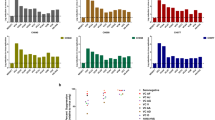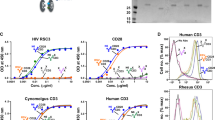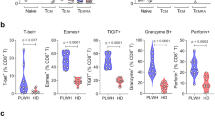Abstract
HIV-1 use CD4 receptors to infect their primary targets, CD4+ cells, whereas CD8+ cells have a protective role against HIV-1. We recently isolated HIV-1-producing CD8+ clones from two AIDS patients. Here we show that although HIV-1 produced by CD8+ cells maintained the ability to infect CD4+ cells, these viruses were able to infect CD8+ cells independent of CD4. Evidence indicates that these viruses used CD8 as a receptor to infect CD8+ cells. First, expression of CD8 was downmodulated after infection. Second, anti-CD8 antibodies blocked viral entry and replication in CD8+ cells. Finally, resistant cells became susceptible after expression of CD8. Although these viruses used CXCR4 to enter CD4+ cells, it seems that infection of CD8+ cells was independent of CXCR4 or CCR5 co-receptors. Novel changes were observed in envelope sequences of CD8-tropic viruses. These results provide initial evidence that HIV-1 can mutate to infect CD8+ cells using CD8 as a receptor.
This is a preview of subscription content, access via your institution
Access options
Subscribe to this journal
Receive 12 print issues and online access
$209.00 per year
only $17.42 per issue
Buy this article
- Purchase on Springer Link
- Instant access to full article PDF
Prices may be subject to local taxes which are calculated during checkout







Similar content being viewed by others
References
Robey, W.G. et al. Characterization of envelope and core structural gene products of HTLV-III with sera from AIDS patients. Science 228, 593–595. (1985).
Flamand, L. et al. Activation of CD8+ T lymphocytes through the T cell receptor turns on CD4 gene expression: implications for HIV pathogenesis. Proc. Natl. Acad. Sci. USA 95, 3111–3116. (1998).
Kitchen, S.G., Korin, Y.D., Roth, M.D., Landay, A. & Zack, J.A. Costimulation of naive CD8(+) lymphocytes induces CD4 expression and allows human immunodeficiency virus type 1 infection. J. Virol. 72, 9054–9060. (1998).
Saha, K., Zhang, J. & Zerhouni, B. Evidence of productively infected CD8+ T cells in patients with AIDS: implications for HIV-1 pathogenesis (manuscript submitted).
Saha, K., Sova, P., Chao, W., Chess, L. & Volsky, D.J. Generation of CD4+ and CD8+ T-cell clones from PBLs of HIV-1 infected subjects using herpesvirus saimiri. Nat. Med. 2, 1272–1275 (1996).
Saha, K., Bentsman, G., Chess, L. & Volsky, D.J. Endogenous production of β-chemokines by CD4+, but not CD8+, T-cell clones correlates with the clinical state of human immunodeficiency virus type 1 (HIV-1)-Infected individuals and may be responsible for blocking infection with non-syncytium-inducing HIV-1 in vitro. J. Virol. 72, 876–881 (1998).
LaBranche, C. et al. Determinants of CD4 independence for a human immunodeficiency virus type 1 variant map outside regions required for coreceptor specificity. J. Virol. 73, 10310–10319. (1999).
Reeves, J.D. et al. Primary human immunodeficiency virus type 2 (HIV-2) isolates infect CD4-negative cells via CCR5 and CXCR4: comparison with HIV-1 and simian immunodeficiency virus and relevance to cell tropism in vivo. J. Virol. 73, 7795–7804. (1999).
Dumonceaux, J. et al. Spontaneous mutations in the env gene of the human immunodeficiency virus type 1 NDK isolate are associated with a CD4-independent entry phenotype. J. Virol. 72, 512–519. (1998).
Kolchinksy, P. et al. Adaptation of a CCR5-using, primary human immunodeficiency virus type 1 isolate for CD4-independent replication. J. Virol. 73, 8120–8126. (1999).
Hung, C.S., Vander Heyden, N. & Ratner, L. Analysis of the critical domain in the V3 loop of human immunodeficiency virus type 1 gp120 involved in CCR5 utilization. J. Virol. 73, 8216–8226 (1999).
Wei, X. et al. Viral dynamics in human immunodeficiency virus type 1 infection. Nature 373, 117–122 (1995).
Perelson, A.S., Neumann, A.U., Markowitz, M., Leonard, J.M. & Ho, D.D. HIV-1 dynamics in vivo: virion clearance rate, infected cell life-span, and viral generation time. Science 271, 1582–1586 (1996).
Hoffman, T.L., Stephens, E.B., Narayan, O. & Doms, R.W. HIV type I envelope determinants for use of the CCR2b, CCR3, STRL33, and APJ coreceptors. Proc. Natl. Acad. Sci. USA 95, 11360–11365 (1998).
McMichael, A.J. & Phillips, R.E. Escape of human immunodeficiency virus from immune control. Annu. Rev. Immunol. 15, 271–296 (1997).
Saha, K., McKinely, G. & Volsky, D.J . Improvement of herpesvirus saimiri T cell immortalization procedure to generate multiple CD4+ cells clones from peripheral blood lymphocytes of AIDS patients. J. Immunol. Methods 206, 21–23 (1997).
Meinl, E., Hohlfeld, R., Wekerle, H. & Fleckstein, B. Immortalization of human T cells by herpesvirus saimiri. Immunol. Today 16, 55–58 (1995).
Moriuchi, H., Moriuchi, M., Combadiere, C., Murphy P.M. & Fauci, A.S. CD8+ T-cell–derived soluble factor(s), but not β-chemokines RANTES, MIP-1α, and MIP-1β, suppress HIV-1 replication in monocyte/macrophage. Proc. Natl. Acad. Sci. USA 93, 15341–15345 (1996).
Hwang, S.S., Boyle, T.J., Lyerly, H.K. & Cullen, B.R. Identification of the envelope V3 loop as the primary determinant of cell tropism in HIV-1. Science 253, 71–74 (1991).
Cao, J. et al. Replication and neutralization of human immunodeficiency virus type 1 lacking the V1 and V2 variable loops of the gp120 envelope glycoprotein. J. Virol. 71, 9808–9812. (1997).
Koito, A., Harrowe, G. & Levy, J.A. Functional role of the V1/V2 region of human immunodeficiency virus type 1 envelope glycoprotein gp120 in infection of primary macrophages and soluble CD4 neutralization. J. Virol. 68, 2253–2259. (1994).
Ross, T.M. & Cullen, B.R. The ability of HIV type 1 to use CCR-3 as a coreceptor is controlled by envelope V1/V2 sequences acting in conjunction with a CCR-5 tropic V3 loop. Proc. Natl. Acad. Sci. USA 95, 7682–7686. (1998).
Westervelt, P. et al. Macrophage tropism determinants of human immunodeficiency virus type 1 in vivo. J. Virol. 66, 2577–2582 (1992).
Kwong, P.D. et al. Structure of an HIV gp120 envelope glycoprotein in complex with the CD4 receptor and a neutralizing human antibody. Nature 393, 648–659 (1998).
Rizzuto, C. et al. A conserved HIV gp120 glycoprotein structure involved in chemokine receptor binding. Science 280, 1949–1953 (1998).
Shankarappa, R. et al. Consistent viral evolutionary changes associated with the progression of human immunodeficiency virus type 1 infection J. Virol. 73, 10489–10502 (1999).
Kaneko, H. et al. Human immunodeficiency virus type 2 envelope glycoprotein binds to CD8 as well as to CD4 molecules on human T cells J. Virol. 71, 8918–8922 (1997).
Saha, K., Ware, R., Yellin, M.J., Chess L. & Lowy, I. Herpesvirus saimiri-transformed human CD4+ T cells can provide polyclonal B cell help via the CD40L as well as the TNF-α pathway and through release of lymphokines. J. Immunol. 157, 3876–3885 (1996).
Saha, K., Volsky, D.J. & Matczak, E. Resistance against Syncytium-Inducing Human Immunodeficiency Virus Type 1 (HIV-1) in Selected CD4+ T Cells from an HIV-1-infected Nonprogressor: Evidence of a Novel pathway of Resistance Mediated by a Soluble Factor (s) That Acts after Virus Entry. J Virol. 73, 7891–7898 (1999).
Douglas, N.W. et al. An efficient method for the rescue and analysis of functional HIV-1 env genes: evidence for recombination in the vicinity of the tat/rev splice site. AIDS 10, 39–46 (1996).
Acknowledgements
We thank P.R. Johnson, C.M. Walker, J.I. Mullins, A. van' Wout, P. Gupta, B. Graham and J. Zack for helpful suggestions and critical review of the manuscript; R. Munson for advice for sequencing; K. Howe for help with the phylogenetic analyses; C. McAllister for assistance with flow cytometry; A. Dutcher for support in manuscript preparation; and the Children's Research Institute (Columbus) for support. This work was supported by two grants from NIH (AI-42715 and AI-44974) and a grant from the American Foundation for AIDS Research (AMFAR) to K.S.
Author information
Authors and Affiliations
Corresponding author
Rights and permissions
About this article
Cite this article
Saha, K., Zhang, J., Gupta, A. et al. Isolation of primary HIV-1 that target CD8+ T Lymphocytes using CD8 as a receptor. Nat Med 7, 65–72 (2001). https://doi.org/10.1038/83365
Received:
Accepted:
Issue Date:
DOI: https://doi.org/10.1038/83365
This article is cited by
-
Acquisition of CD4-Dependence by CD4-Independent SIV Passaged in Human Peripheral Blood Mononuclear Cells
Retrovirology (2012)
-
A Mathematical Model of HIV Infection: Simulating T4, T8, Macrophages, Antibody, and Virus via Specific Anti-HIV Response in the Presence of Adaptation and Tropism
Bulletin of Mathematical Biology (2010)
-
A new entry route for HIV
Nature Medicine (2001)
-
Distribution of HIV-1 resistance-conferring polymorphic allelesSDF-1-3′A, CCR2-64I andCCR5-Δ32 in diverse populations of Andhra Pradesh, South India
Journal of Genetics (2001)



